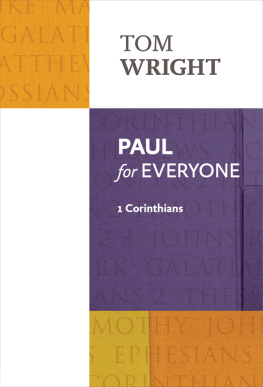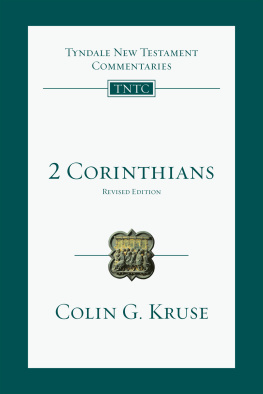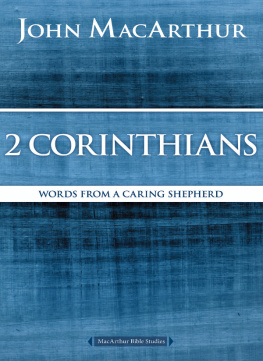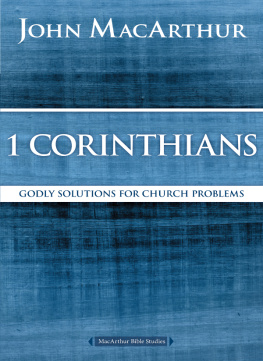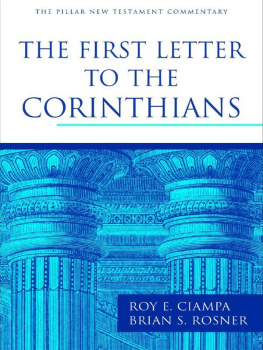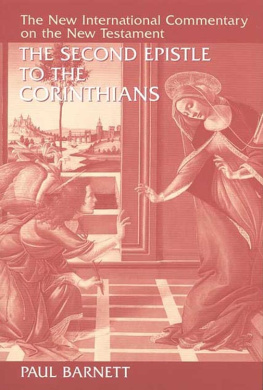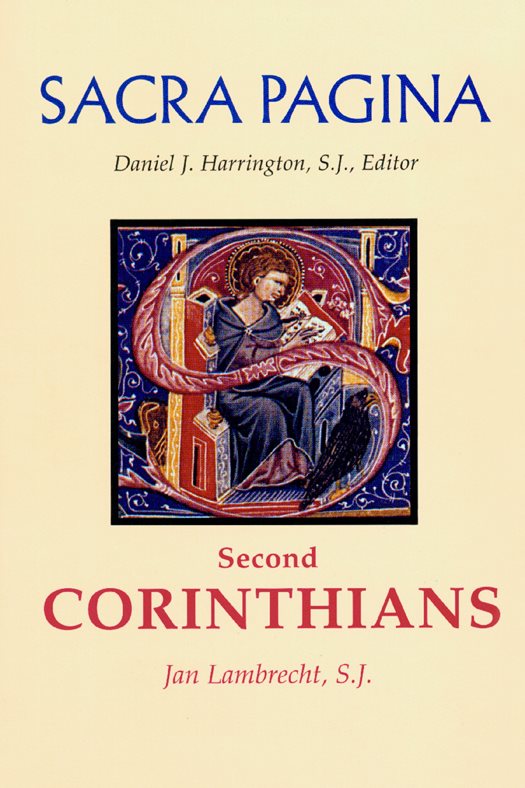
A Michael Glazier Book published by Liturgical Press.
Cover design by Ann Blattner. Illustration reproduced with the permission of the Universittsbibliothek Graz, Austria, Cod. 143, fol. 501b (13th c. Breviarium Benedictinum), from a microfilm in the Hill Monastic Manuscript Library, Collegeville, Minnesota.
1999 by Order of Saint Benedict, Collegeville, Minnesota. All rights reserved. No part of this work may be reproduced in any form or by any means, electronic or mechanical, including photocopying, recording, taping, or any retrieval system, without the written permission of Liturgical Press, Collegeville, MN 56321. Printed in the United States of America.
ISBN 978-0-8146-5971-7 (book)
ISBN 978-0-8146-8288-3 (ebook)
The Library of Congress has cataloged the printed edition as follows:
The Library of Congress has cataloged the hardcover edition as follows:
Lambrecht, Jan.
Second Corinthians / Jan Lambrecht ; Daniel J. Harrington, editor.
p. cm. (Sacra pagina series ;vol. 8)
A Michael Glazier book.
Includes bibliographical references and indexes.
ISBN 0-8146-5810-5 (alk. paper)
1. Bible. N.T. Corinthians, 2ndCommentaries. I. Harrington,
Daniel J. II. Title. III. Series: Sacra pagina series ; 8.
BS2675.3.L36 1998
227.2077dc21
98-19294
CIP
EDITORS PREFACE
Sacra Pagina is a multi-volume commentary on the books of the New Testament. The expression Sacra Pagina (Sacred Page) originally referred to the text of Scripture. In the Middle Ages it also described the study of Scripture to which the interpreter brought the tools of grammar, rhetoric, dialectic, and philosophy. Thus Sacra Pagina encompasses both the text to be studied and the activity of interpretation.
This series presents fresh translations and modern expositions of all the books of the New Testament. Written by an international team of Catholic biblical scholars, it is intended for biblical professionals, graduate students, theologians, clergy, and religious educators. The volumes present basic introductory information and close exposition. They self-consciously adopt specific methodological perspectives, but maintain a focus on the issues raised by the New Testament compositions themselves. The goal of Sacra Pagina is to provide sound critical analysis without any loss of sensitivity to religious meaning. This series is therefore catholic in two senses of the word: inclusive in its methods and perspectives, and shaped by the context of the Catholic tradition.
The Second Vatican Council described the study of the sacred page as the very soul of sacred theology (Dei Verbum 24). The volumes in this series illustrate how Catholic scholars contribute to the councils call to provide access to Sacred Scripture for all the Christian faithful. Rather than pretending to say the final word on any text, these volumes seek to open up the riches of the New Testament and to invite as many people as possible to study seriously the sacred page.
D ANIEL J. H ARRINGTON , S.J.
AUTHORS PREFACE
Scholars and students of Paul know all too well that his second letter to the Corinthians is not easy. There is not only the question of the integrity of 2 Corinthians as a letter, but also the fact that adequate information is lacking about the concrete situation at Corinth and the identity of Pauls opponents. Moreover, the Greek of this letter is difficult, partly due no doubt to Pauls emotional style. Yet 2 Corinthians is of utmost importance, especially because of Pauls ongoing reflection on his ministry.
The writer of this commentary has tried to adhere to the guidelines of the Sacra Pagina series by offering here a one-volume commentary without footnotes and without expanded surveys of the history of interpretation. Brevity of exposition has been a primary goal. A new translation has been prepared. A distinction is made between the verse-by-verse exegesis (Notes) and the more theological explanation (Interpretation). Finally, only a few titles, mostly English, have been added for reference and further study.
My translation is as literal as possible and is intended to help readers to detect precisely what Paul has in mind, his reasoning and the flow of his thought. More than once it was necessary to add some words and even phrases in parentheses to conform to English grammar. In the notes the translation is repeated clause by clause for the sake of easier discussion. Greek words and constructions are given in transliteration followed by the translation in parentheses. For passages from the Septuagint I have sometimes used the translation by L.C.L. Brenton, The Septuagint with Apocrypha: Greek and English (repr. Grand Rapids: Zondervan, 1982). As is further explained at the end of the Introduction, the material in the interpretation is divided into four (unequal) sections. The readers will notice that this commentary argues for the integrity of 2 Corinthians. On this position well-known commentators such as C. K. Barrett, Rudolf Bultmann, Maurice Carrez, Victor P. Furnish, Hans-Josef Klauck, Ralph P. Martin, Alfred Plummer, Margaret E. Thrall, Hans Windisch, and Christian Wolff differ. These authors, however, along with many other commentators and writers of monographs or articles, are gratefully remembered here.
I am very much indebted to two of my former students at the Katholieke Universiteit in Leuven, both of whom are now professors and specialists in Pauline studies. Dr. Veronica Koperski, S.F.C.C. , Barry University (Florida), has corrected and refined the English and made a number of useful suggestions pertaining to the content. Dr. Reimund Bieringer, Katholieke Universiteit of Leuven (Belgium), carefully read a first version of this commentary and in protracted discussions reacted critically to it. I am convinced that neither would have written the text in the way I did, yet I remain deeply grateful to them for their generous and time-consuming help. I wish also to thank the students in Leuven, as well as those in Rome, who by their interaction during classes and seminars took part in the preparation of this work. It is an honor for a non-American and, moreover, one who is not a native English speaker to have been invited to write in Sacra Pagina. For this I want to thank Michael Glazier and the editor of the series, Daniel J. Harrington, S.J . Finally, I also extend thanks to my religious superiors in Belgium for their support, and I am likewise grateful to the staff of the Pontifical Biblical Institute in Rome for repeated invitations to teach on 2 Corinthians and other letters of Paul. Life in the Jesuit community of the Institute and use of its excellent library have proven no small help during the last stages of the composition of this commentary.
The Second Letter to the Corinthians is theologically and autobiographically highly significant. May this most personal of Pauls weighty and strong (10:10) letters continue to contribute toward the building up (13:10) of its readers.
January 25, 1998 | Jan Lambrecht, S.J . |
Feast of the Conversion of Paul, Apostle | Pontifical Biblical Institute, Rome |
ABBREVIATIONS
Biblical Books and Apocrypha
Gen | Nah | 1234 Kgdms | John |
Exod | Hab | Add Esth |



